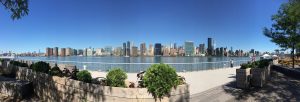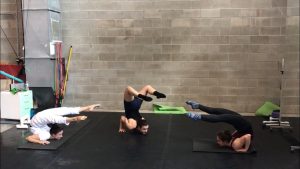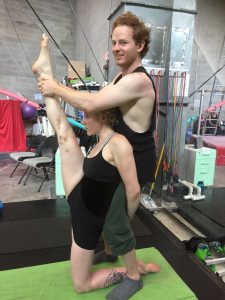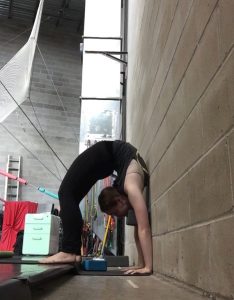My focus this summer is the circus community at Circus Warehouse in Long Island City, Queens. For the last few months, I have spent north of 15 hours per week training with, observing, and interviewing members of the Professional Intensive Program, many of whom are in the process of workshopping performance pieces due to be presented in September.

Though my research was intended to focus on the circus community and students’ relationships with people within circus and outside of circus, I have found myself also being drawn to questions regarding the adaptability of our bodies and how we perceive space around us. Perhaps I am partially motivated by my own course of study, which is centered on contortion, but this different focus has also grown from interview answers to questions about what drives these artists to choose certain apparatuses over others, and how they interact with circus people versus non-circus people.

I recently interviewed a student named William (Will) Johnson who is a multitalented aerialist from Sydney, now living and training in New York City. When I asked Will why he has chosen to pursue his choice apparatuses, he turned to examples of how his own body engages similarly or differently when sharing space with varying equipment; for instance, a static trapeze, which is both a hard (bar) and a soft (rope) apparatus, requires pulling with the shoulder engaged in a downward motion and the back muscles knit together for support. A soft apparatus like aerial rope requires markedly different engagement from surrounding shoulder muscles, and we take into account that the rope is in front of the body when hanging from straight arms. A person training both trapeze and rope must be able to identify this physical difference in their engagement while practicing. There are disciplines which interact nicely, such as aerial straps and handstands, due to shoulder mobility and strength, core stability, and a host of other factors which I can’t begin to identify, and there are some which seems to actively counteract each other, such as most aerial work and shoulder flexibility in contortion.

Not long after speaking with Will, a different friend and I began training our overhead catch skills in contortion; that is, we started developing our abilities to reach up behind our heads to grab our feet without any visual reference point. It is deceptively challenging, and both of us found that sly shoulder rotation and leg turnout prevented us from knowing where we were placing our own limbs in space. The help of a mirror, a guiding hand, and auditory cuing eventually led our hands to our feet, and I later dove into conversation with a Warehouse coach about kinesthetic awareness and the mind/body disconnect I found myself experiencing. Of the many discussions I have had this summer pertaining to my research, I am most captivated by this idea that a body can have knowledge that its corresponding mind does not, and vice versa. I hope to follow this thread in the remaining weeks of this summer to see where it leads me!

To close, here, are a few details I have picked up on:
- Progress is nonlinear.
- The biggest challenge one may face is not learning to do a trick, but rather finding peace and breath in discomfort while learning.
- Being in a community of people who are capable of completing extraordinary things on a daily basis shifts our perception of not only what the human body can do, but what our own bodies can achieve.

Wow this is fascinating! Ever since I took a summer course at the University of Chicago (where there is an ample circus scene), I have wondered what draws people to such a seemingly eccentric and arguable anachronistic discipline. I really appreciate your engagement with the corporal significance of the work, as well as how you touch on the sense of community this activity fosters. Bravo on the profound realization that “a body can have knowledge that its corresponding mind does not, and vice versa.” Truly compelling.
I look forward to hearing more about your discoveries about proving your impossibilities possible 🙂 I would be interested in learning more about their flexibility improvement plans as well.